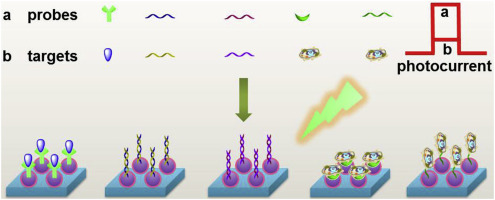戴志晖教授课题组在TRAC-TRENDS IN ANALYTICAL CHEMISTRY发表研究论文
Selective photoelectrochemical architectures for biosensing: Design, mechanism and responsibility
Tu, WW (Tu, Wenwen); Wang, ZY (Wang, Zhaoyin); Dai, ZH (Dai, Zhihui)[ 1 ](戴志晖)*
[ 1 ] Nanjing Normal Univ, Coll Chem & Mat Sci, Jiangsu Collaborat Innovat Ctr Biomed Funct Mat, Nanjing 210023, Jiangsu, Peoples R China
[ 2 ] Nanjing Normal Univ, Coll Chem & Mat Sci, Jiangsu Key Lab Biofunct Mat, Nanjing 210023, Jiangsu, Peoples R China
TRAC-TRENDS IN ANALYTICAL CHEMISTRY,201808,105,470-483
Photoelectrochemical (PEC) biosensing is a newly developed and promising analytical technique. The complete separation of excitation source (light) and detection signal (current) greatly reduces the undesired background signal, which is advantageous over both optical and electrochemical determination. Using a photocurrent from the PEC process as a detection signal, PEC biosensor can be operated at a low applied potential and exhibits high sensitivity with repeating cycles. In this account, we summary recent results in the study on PEC biosensing. To construct PEC sensors, exciting light sources of chemiluminescence (CL) and electrochemiluminescence, and PEC active materials including the selected semiconductors, dyes, composites of semiconductors-semiconductors and hybrids of dyes-semiconductors are employed. The principle of PEC biosensing is described and the mechanism in anodic and cathodic photocurrent generation processes is well investigated. On the other hand, in typical PEC biosensors, biomolecules such as antibodies and nucleic acids, are immobilized on the biosensing interface and bind with their corresponding targets via chemical reaction or biological recognition, enabling quantitative detection of the targets possible according to the variation of the photocurrents. Finally, several examples with the PEC biosensing application including immunosensors, DNA sensors, RNA sensors, aptasensors, enzymatic analysis, cytosensors, and detection of small molecules and metal ions are briefly introduced.

文章链接:
https://www.sciencedirect.com/science/article/pii/S016599361830195X?via%3Dihub
版权与免责声明:本网页的内容由收集互联网上公开发布的信息整理获得。目的在于传递信息及分享,并不意味着赞同其观点或证实其真实性,也不构成其他建议。仅提供交流平台,不为其版权负责。如涉及侵权,请联系我们及时修改或删除。邮箱:sales@allpeptide.com